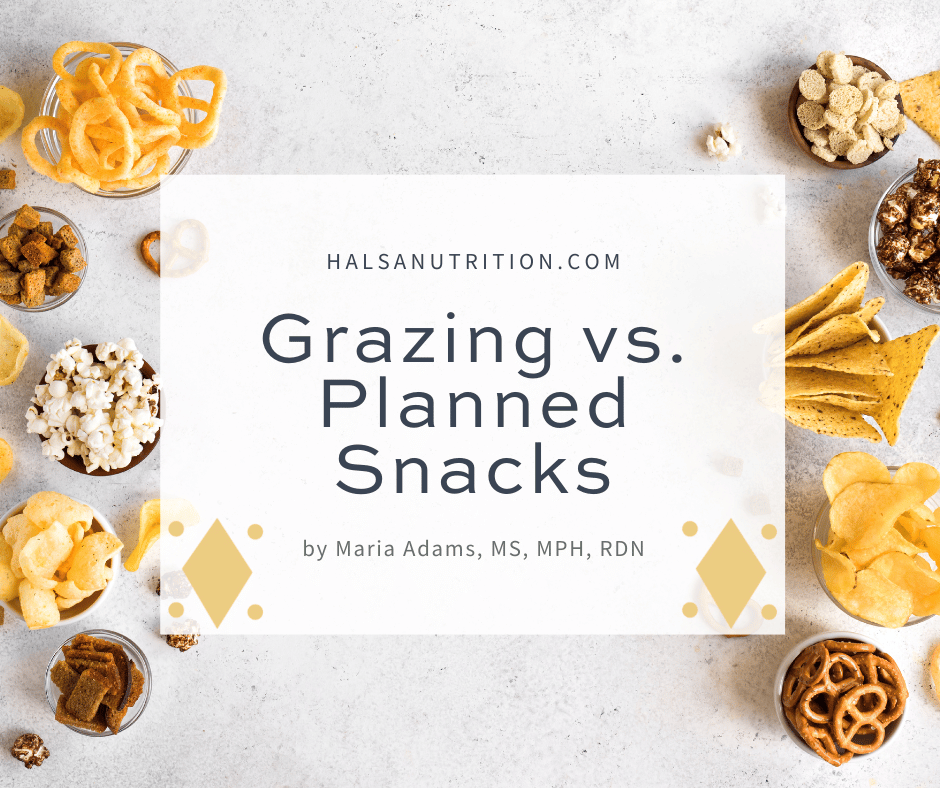
Grazing vs. Planned Snacks
Grazing vs. planned snacks. Which is better? The answer depends, though kids almost always benefit from planned snacks.
Estimated reading time: 5 minutes
If you find yourself grazing, you are not alone. Grazing, or snacking frequently throughout the day, is a common habit. It’s even more common when we are working from home and have access to snacks all day.
So is grazing ok? Or is it better to have fewer, more planned snacks and meals? And what is ideal for kids?
As a dietitian with an intuitive eating philosophy, I believe that we don’t need “rules” to tell us how to eat. It’s more important to be in tune with our bodies and recognize what works for us. For some people, that may include grazing. For many others, eating less frequently and with more structure is ideal. The bottom line is that you need to do what works for you, but here are some points to keep in mind.

Mindful Grazing
When it comes to eating, one of the most important factors is mindfulness. Are you mindlessly munching or are you eating with intention and mindfulness?
In general, we tend to associate grazing with mindless eating, but it is possible to have many small snacks throughout the day and eat them mindfully. Consider these two examples:
Example 1: You walk by the drawer with the leftover Halloween candy. You grab a mini-sized Twix and pop it in your mouth. It was good but so quick to eat, and you were busy thinking about other things. You go back and grab a couple more and pop those in your mouth too.
An hour later you find yourself eating your child’s leftover crackers while you are cleaning up in the kitchen and scrolling through social media at the same time. You know, “multitasking”.
Example 2: You make a cup of coffee and decide that it would be delicious to have a little sweet to go with it. You mindfully savor a piece of chocolate. It was delicious. Perhaps you have another. Perhaps you are satisfied. Either way, it was a mindfully eaten and savored piece of chocolate!
An hour later you grab a handful of almonds and blueberries to keep you going until lunch. You stand still and savor. You realize you are thirsty and also drink some water.
Recognizing the Why
If you are eating mindfully it will also help you recognize why you are eating. Before you decide to have a snack, notice your level of hunger. If you are not hungry are you eating because you are thirsty? Because the food will bring you pleasure? Because you are bored, stressed, or sad?
While it’s ok and normal to eat for non-hunger reasons, it’s more common to do so when you graze.
Recognizing the What
Additionally, when we graze we often make different food choices than when we have planned snacks. For example, we often turn to convenient “snack” foods such as chips, pretzels, cookies, and candy. That said, if you put out a bowl of berries or a tray of sliced veggies, there’s a good chance you will reach for those when you graze as well.

When we make a plan to have a mindful snack we are more likely to include nutrient-dense foods such as fruits, veggies, whole grains, and protein. In addition, we will probably put a little more time and effort into our snacks. Of course, sometimes the stars of our mindful snack will be pleasure and satisfaction, for example when we savor delicious, freshly made cookies.
So It’s Better to Plan Snacks?
Adults
For adults, I recommend doing what works for you and your lifestyle. If you feel great as a grazer you don’t need to change your habits. However, if you find that you are consuming more or fewer snacks than you would like, eating less nutritiously than you would like, not mindfully eating, or not hungry enough come regular meals, perhaps it’s time for more structure. (In addition, know that frequent snacking could increase your risk of cavities.)
Kids
When it comes to kids, however, planned snacks are the way to go. Kids, especially younger kids, thrive on routine and structure. Having a schedule will help them know what to expect in the day and help them come to the table hungry.
Having a meal schedule also helps establish positive eating habits. For example, when they ask to have something between meals or snacks, instead of just saying “no” you can say “we aren’t having pretzels now, but we can have them with our afternoon snack at 3 pm.”
Once snack time rolls around you can serve the pretzels alongside a fruit or veggie and protein. Planning the snack will make it more balanced and nourishing and give them the energy they need to keep going until the next meal. Eating just a handful of pretzels, however, will probably leave them hungry an hour later.
(Read more about how to feed kids here.)
Adolescence
Of course, once your kids reach adolescence all this structure can start to go out the window. As they become more independent, they may find themselves deciding when they are hungry and preparing their own snacks. Rather than enforcing set snack times, tell them they can have a snack when they choose, but to try to make it mindful. You can encourage mindful eating and nourishing choices by hanging this handout on your pantry or fridge door.
Leave a Reply